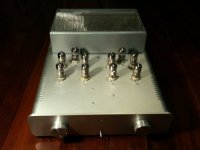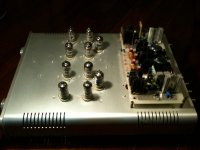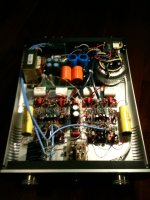I have built two versions of the FTP5. All point to point and I never had issues with noise or hum. I found them one of the easiest things I have built.
Shoog
Wiring a ecl82/86 tube amp, that is difficult !
Wiring a ecl82/86 tube amp, that is difficult !
I'am onto about my 10th amp build sofar and each had there own set of problems. My last build, a direct coupled Schade 807 amp, took nearly a year to resolve issues with blowing CCS. That was very fustrating. Then of course on my first build of a Zen V3 I took out £150.00 worth of MOSFETS on the first power up
As I said, both versions of my FVP5 have worked prity much first time and sounded good from the off. Its not that difficult a circuit to build if you keep everything straight on the pins.
Shoog
I have to agree that point-to-point building is in some ways much more satisfying than PCB wiring - especially if there is a problem to hunt down!
When some of the MOSFETS in my crossover turned out to be faulty, it was a relatively simple matter to replace them. By contrast, when I had problems with the double-sided shunt regulator PCB, every time I unsoldered a component some of the copper came with it. By the time the regulator was working, about half the board was point-to-point wired anyway...
Alex
When some of the MOSFETS in my crossover turned out to be faulty, it was a relatively simple matter to replace them. By contrast, when I had problems with the double-sided shunt regulator PCB, every time I unsoldered a component some of the copper came with it. By the time the regulator was working, about half the board was point-to-point wired anyway...
Alex
Hello, I have built a point to point FVP5 but used the super regulator in kit form, as sold by Allen. I had tried to build the super.reg in my own (different) pcb and had instability and VHF oscillation problems. This circuit is fantastic, now a fiend is using it in a system with Grand Utopia speakers. adam2a3
Hello, I have built a point to point FVP5 but used the super regulator in kit form, as sold by Allen. I had tried to build the super.reg in my own (different) pcb and had instability and VHF oscillation problems. This circuit is fantastic, now a fiend is using it in a system with Grand Utopia speakers. adam2a3
Did you use the 20 cents LF351 opamp that is delivered with the reg kit ?
Hello, Allen included an OPA1 opamp in the superegulator kit, not an LF353. Also supplied the fets for the RIIA input stage. The supereg's external 24V dc supply I used was a regulated Power One, and B+ came from a 350W transformer plus 5V4 with LCLC. Interconnects betrween Supereg and circuit modules were mirrored lengths of 1/2" copper stripes dressed by heatshrink. I might upload some photos, that I have in another pc and is not possible now. adam2a3
What is an opa1? I don't seem to find any specs for it. I have a pair of old superreg and would like to upgrade the LF351 to something better. Any chance to PM me the real opamp name??
AD797 has succesfully been used as an upgrade
Thank you!!AD797 has succesfully been used as an upgrade
Thank you!!
do not forget a 100nF ceramic across pin 4 and 7 (backside pcb, close to the pins)
Guys,
I appreciate all the nice words about the RTP3 and FVP5 designs.
But a lot of incorrect facts have got into this thread.
1/ We still sell the RTP3D as a kit with EVERYTHING you need to build an exact duplicate of our factory units.
2/ We also sell full kits for the SVP-2, which is the updated production version of the FVP-5A.
3/ I have not used or recommended jfets in the phono section of the RTP3 for perhaps 10 years. Initally I used the MAT02 but now use the SAME chip but in a DIL 8 pin plastic package, the SSM2010. Same specs, same performance.
This matched bipolar brings another 10dB of gain to the phonostage, making the gain structure better matched with low output MC carts. It's also state of the art quiet!
3/ The SuperReg is vital in my designs, and if you don't use it and are happy, good for you, but you have not heard what the circuit can do.
4/ There are two upgrades for the SReg, one is to use a AD797 opamp (with a 0.1 or 1uF ceramic SMD cap across the powersupply pins), the second is to toss the LM317 in the CCS section, because it honestly sound FAR better and stable without it. Most kits shipped in the past 5 years have had that page included in the instructions.
If you PM me, I will mail you the page on how to do this.
4/ Those of you who have built one of my designs OWE me - you owe me photos of your creation!
5/ If you want to build a RTP3D, then the full kit is the smart idea - but if you want to go for it by yourself, then for 100 euro I will send you the full instruction CDR that comes with the kit - it contains a LOT more than just the basic schematic that's on my website - like a full parts list.
6/ And what do they sound like? Holgar hit right on the nail, clean, extremely fast, extremely dynamic, and no "tuby" colourations. Hugely coherent across the whole frequency spectrum.
The FVP-5A is similar, but a little more "raw" sounding, less refined. Some people into rock/blues have said they prefer the FVP-5A, although admitting the RTP3D is a "better" preamp.
Note: I no longer recommend building the basic FVP-5 (or the RTP-5) with the MOSFETs in the line stage. MOSFETS have NO place in an audio signal path IMO, and the sonic improvement of the FVP-5A over the FVP-5 made this decision very very clear!
Regards, Allen
I appreciate all the nice words about the RTP3 and FVP5 designs.
But a lot of incorrect facts have got into this thread.
1/ We still sell the RTP3D as a kit with EVERYTHING you need to build an exact duplicate of our factory units.
2/ We also sell full kits for the SVP-2, which is the updated production version of the FVP-5A.
3/ I have not used or recommended jfets in the phono section of the RTP3 for perhaps 10 years. Initally I used the MAT02 but now use the SAME chip but in a DIL 8 pin plastic package, the SSM2010. Same specs, same performance.
This matched bipolar brings another 10dB of gain to the phonostage, making the gain structure better matched with low output MC carts. It's also state of the art quiet!
3/ The SuperReg is vital in my designs, and if you don't use it and are happy, good for you, but you have not heard what the circuit can do.
4/ There are two upgrades for the SReg, one is to use a AD797 opamp (with a 0.1 or 1uF ceramic SMD cap across the powersupply pins), the second is to toss the LM317 in the CCS section, because it honestly sound FAR better and stable without it. Most kits shipped in the past 5 years have had that page included in the instructions.
If you PM me, I will mail you the page on how to do this.
4/ Those of you who have built one of my designs OWE me - you owe me photos of your creation!
5/ If you want to build a RTP3D, then the full kit is the smart idea - but if you want to go for it by yourself, then for 100 euro I will send you the full instruction CDR that comes with the kit - it contains a LOT more than just the basic schematic that's on my website - like a full parts list.
6/ And what do they sound like? Holgar hit right on the nail, clean, extremely fast, extremely dynamic, and no "tuby" colourations. Hugely coherent across the whole frequency spectrum.
The FVP-5A is similar, but a little more "raw" sounding, less refined. Some people into rock/blues have said they prefer the FVP-5A, although admitting the RTP3D is a "better" preamp.
Note: I no longer recommend building the basic FVP-5 (or the RTP-5) with the MOSFETs in the line stage. MOSFETS have NO place in an audio signal path IMO, and the sonic improvement of the FVP-5A over the FVP-5 made this decision very very clear!
Regards, Allen
If you want a photo or two of my build of the FVPA I can take some and post. Its not really the same beast as the original because it uses ECL80's with pentodes as the CCS and triode strapped pentodes on the top. It also has a simple CRCL power supply with 6X4 rectifiers, so again its not your design. Still I love it and have loved the slow evolution of my first gainclone CF buffer through about 5yrs of tweaks to what it is now. I feel certain I will change it again, but don't feel compelled to go balanced any time soon.
Cheers.
Shoog
Cheers.
Shoog
Vacuum State RTP3
Hi Allen,
I bought the preamp cookbook from you a few year back. I've built both FVP and RTP, only the linestage though. Here're what I owe you. Sorry for the rather poor photo quality.
Thank you very much, Allen
Prakit
Guys,
4/ Those of you who have built one of my designs OWE me - you owe me photos of your creation!
Allen
Hi Allen,
I bought the preamp cookbook from you a few year back. I've built both FVP and RTP, only the linestage though. Here're what I owe you. Sorry for the rather poor photo quality.
Thank you very much, Allen
Prakit
Attachments
OK, here are my own RTP3 pictures (Allen - you have already seen these):
My project copied the layout of the "official" RTP3C as closely as possible. Mine uses a shunt regulator, but it is Emile Sprenger's HPHV, and not Allen's SuperReg.
Alex
An externally hosted image should be here but it was not working when we last tested it.
An externally hosted image should be here but it was not working when we last tested it.
My project copied the layout of the "official" RTP3C as closely as possible. Mine uses a shunt regulator, but it is Emile Sprenger's HPHV, and not Allen's SuperReg.
Alex
Last edited:
The OPZ of the RTP3C/D is around 100 ohms per phase, as actually measured and not just calculated. So it will drive long output cables with ease. Our SilverFoil cables are VERY high capacitance ( circa 1000pF/meter) and it drives 3 meter lengths of them with ease. We can't make them longer so can't test longer than that.
If you want to use the RTP in a situation with a very low impedance input poweramp, or some 600 ohm studio gear, you may need to increasethe size of the output cap to allow the full passage of the extreme low LF signals it's capable of. 10uF would be a good starting point.
Transformer V/C, I ask "why?" I hate all signal level transformers, finding they destroy the downward dynamic range by actual listening test. And if you want to build a full RTP, with the phono section, it just flat out won't work, as the phono section needs a very accurate and constant 50k load on it for it's RIAA to be accurate. Change that 50K and you chanage the RIAA eq.
A trafo V/C has no defined input impedance, only can reflect the seconary load, with different reflectances with each transformer step setting - creating a HORRIBLE RIAA eq situation.
If you just want to build the line stage, then that's not important, but if you just want to use it with an opamp laden CD player, then I say why bother, why waste you time and money?
The RTP3C/D was intended to be an EXTREME quality device - better than anything otherwise available, and if you look up it's latest review (on our home page) it seems to be gaining that reputation, at long last.
It was intended to be for vinyl, with the best cartridge and T/T setup, but a de-opamped SACD player, or open reel tape deck is also OK in my thinking.
Regards, Allen
If you want to use the RTP in a situation with a very low impedance input poweramp, or some 600 ohm studio gear, you may need to increasethe size of the output cap to allow the full passage of the extreme low LF signals it's capable of. 10uF would be a good starting point.
Transformer V/C, I ask "why?" I hate all signal level transformers, finding they destroy the downward dynamic range by actual listening test. And if you want to build a full RTP, with the phono section, it just flat out won't work, as the phono section needs a very accurate and constant 50k load on it for it's RIAA to be accurate. Change that 50K and you chanage the RIAA eq.
A trafo V/C has no defined input impedance, only can reflect the seconary load, with different reflectances with each transformer step setting - creating a HORRIBLE RIAA eq situation.
If you just want to build the line stage, then that's not important, but if you just want to use it with an opamp laden CD player, then I say why bother, why waste you time and money?
The RTP3C/D was intended to be an EXTREME quality device - better than anything otherwise available, and if you look up it's latest review (on our home page) it seems to be gaining that reputation, at long last.
It was intended to be for vinyl, with the best cartridge and T/T setup, but a de-opamped SACD player, or open reel tape deck is also OK in my thinking.
Regards, Allen
Thanks Allen. The input impedance on the power amps would be 100k. As for cable length I would need roughly 20-25 feet for my planned listening room. I do intend to use it as a full preamp with the phono section, with a LOMC. The TVC question was just me thinking out loud, I have no objections to a resistor stepped attenuator.
Hi,
Being a transformer guy, I don't agree with Allen's remarks on transformers as it is quite overgeneralized.
There are applications where a transformer is simply necessary (think of your 300B PP amp Allen) or one of the best options (for instance MC step-up transformers).
Speaking of volume controls, my autotransformer volume control beats every "normal" volume pot (up to Penny and Giles) and series or ladder networks with fixed resistors when it is used the right way by sounding completely neutral. With it's 30 ohms total DC resistance it is excellent for DDR.
Cheers,
Pieter
Being a transformer guy, I don't agree with Allen's remarks on transformers as it is quite overgeneralized.
There are applications where a transformer is simply necessary (think of your 300B PP amp Allen) or one of the best options (for instance MC step-up transformers).
Speaking of volume controls, my autotransformer volume control beats every "normal" volume pot (up to Penny and Giles) and series or ladder networks with fixed resistors when it is used the right way by sounding completely neutral. With it's 30 ohms total DC resistance it is excellent for DDR.
Cheers,
Pieter
There are applications where a transformer is simply necessary (think of your 300B PP amp Allen) or one of the best options (for instance MC step-up transformers).
I said "signal level" transformers, and imn that I meant line level and below. I didn't mean OPTs where the power level is far higher.
And I don't agre with using trafos for MC step-up - none I have heard get close to a good active stage - in my experience.
Regards, Allen
- Home
- Amplifiers
- Tubes / Valves
- Vacuum State RTP3C


